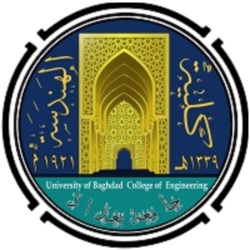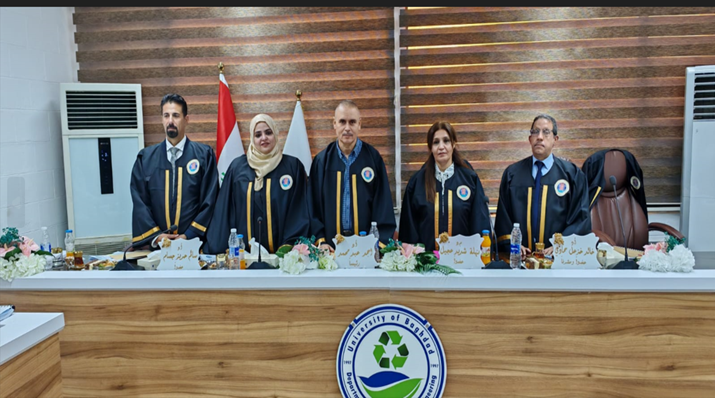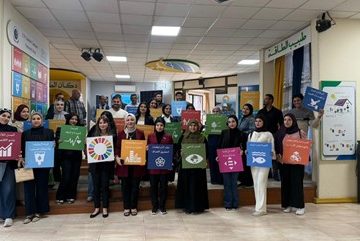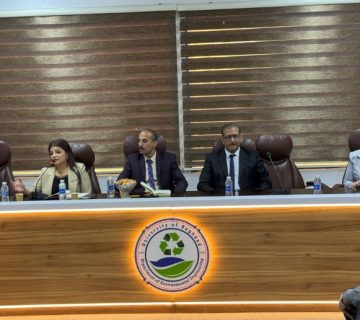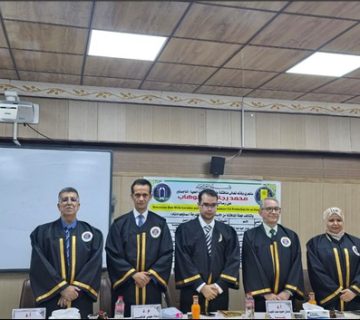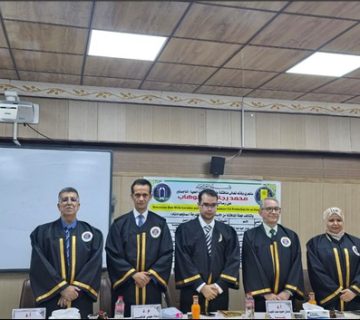Environmental Engineering Department at the College of Engineering, University of Baghdad, held MSc dissertation examination titled:
“Performance of porcelanite -SiO2 nano- composite adsorbent for removal of levofloxacin antibiotic from aqueous solutions “
By the student Zainab Ghalil Salman and supervised Prof. Dr. Khalid Khazaal Humadi on Sunday 31/8/2025, in the Environmental Engineering discussion hall. The examination committee consisted of Prof. Dr. Ahmed Abd Muhammed as Chairman, and the membership of Prof. Dr. Salim Haraze Jassam and Lect. Dr. Nahla Shadeed Ageel. After conducting the public discussion and listening to the student’s defense, the dissertation was accepted. It was summarized as follows:
This study examines the effectiveness of Iraqi porcelanite rock, porcelanite -SiO2 nano-composite, as a low-cost adsorbent for the removal of the antibiotic levofloxacin from aqueous solutions. In batch and continuous fluidized bed column systems, Adsorption experiments were conducted in both batch and continuous fluidized bed column, different techniques were used such as FTIR, XRD, SEM, the adsorbent characterized before and after the adsorption process using various analytical techniques. The batch experiments such as (pH, contact time, initial levofloxacin concentration, adsorbent dosage, temperature, and particle size) have been investigated.The results showed that functional groups like carbonyl and hydroxyl on the surface of the (porcelanite -SiO2 nano-composite) and natural porcelanite rock play a key role in attracting and holding onto the antibiotic molecules. The best adsorption conditions for a 10 mg/L LEV solution were 0.15 g/50 mL of porcelanite rock and 0.08 g/50 mL of (porcelanite -SiO2 nano-composite), with a pH of 6 porcelanite -SiO2 nano-composite and 6.5 for natural procelanite , particle size of both natural proclinate and porcelanite -SiO2 nano-composite 424 µm, shaking speed of 200 rpm, and temperature of 298.15 K. The experimental data on the adsorption of LEVO onto Porcelanite rock and (porcelanite -SiO2 nano-composite) fit pseudo-second-order kinetics. While the isotherm study confirmed that the Langmuir model is more fitting for both porcelanite and NanoSiO2/porcelanite. The maximum adsorption capacity was 52.322 and 130 mg/g for porcelanite rock and (NanoSiO2/porcelanite), respectively. The thermodynamics show that the negative value of ΔHº indicates that the adsorption is exothermic,The continuous systems, a fluidized bed column was employed to assess the effects of bed height, flow rate, and initial LEV concentration. Results showed that higher bed heights improved adsorption efficiency, while increased flow rates reduced external mass transfer resistance. The breakthrough curves confirmed that Nano SiO₂/ porcelanite had superior performance under varying operational conditions. The findings confirm that porcelanite -SiO2 nano-composite is a promising, eco-friendly, and effective adsorbent for LEV removal from wastewater, offering improved performance over unmodified natural materials.
The Recommendations of this dissertation.
- Study the capability of using porcelanite and modified porcine to remove other pollutants, such as organic pollutants and inorganic pollutants, from wastewater, such as dyes, in batch and continuous flow systems.
- Study the possibility of mixing porcelanite with other low-cost materials, such as activated carbon, to increase its potential capability in removing antibiotics.
